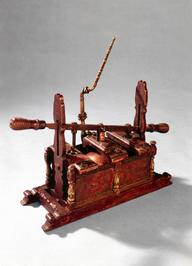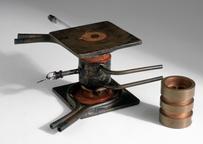







Working model of a vertical cylinder steam fire engine, (scale 1:48)
This is a model of the Shand Mason vertical-cylinder steam fire engine. In the nineteenth century, Shand, Mason and Company was one of the two leading makers of fire-fighting appliances in Britain. Their vertical-cylinder steam fire engine was introduced in 1863 as the 'London Brigade Vertical'. It was a popular choice by fire brigades in Britain and overseas in the last quarter of the century. Horses towed the appliance to the scene of the fire; the steam engine powered the water pumps. Thomas Coates made this model, to scale 1:4.8, during the 1880s. Coates ran a business as an engineering model maker in addition to his daytime job as senior draughtsman for James Watt and Company. The model was made to a high standard of accuracy. It is, in all respects, a complete working machine. The copper boiler has 70 cross tubes. It was tested to 300lb per square inch, burns coal, and can raise steam from cold water in seven minutes. The model engine throws a continuous jet of water 0.187 inches in diameter to a height of 65 feet when running at 360 revolutions per minute. The model obtained the first prize medal at the 1888 Industrial Exhibition held at the People's Palace, Mile End, East London. It was also awarded the Society of Arts medal at an exhibition at the Crystal Palace, south London, in the same year. The Science Museum purchased the model for display in 1891.
Details
- Category:
- Firefighting
- Object Number:
- 1891-168 Pt1
- type:
- model - representation
- credit:
- Thomas Coates




